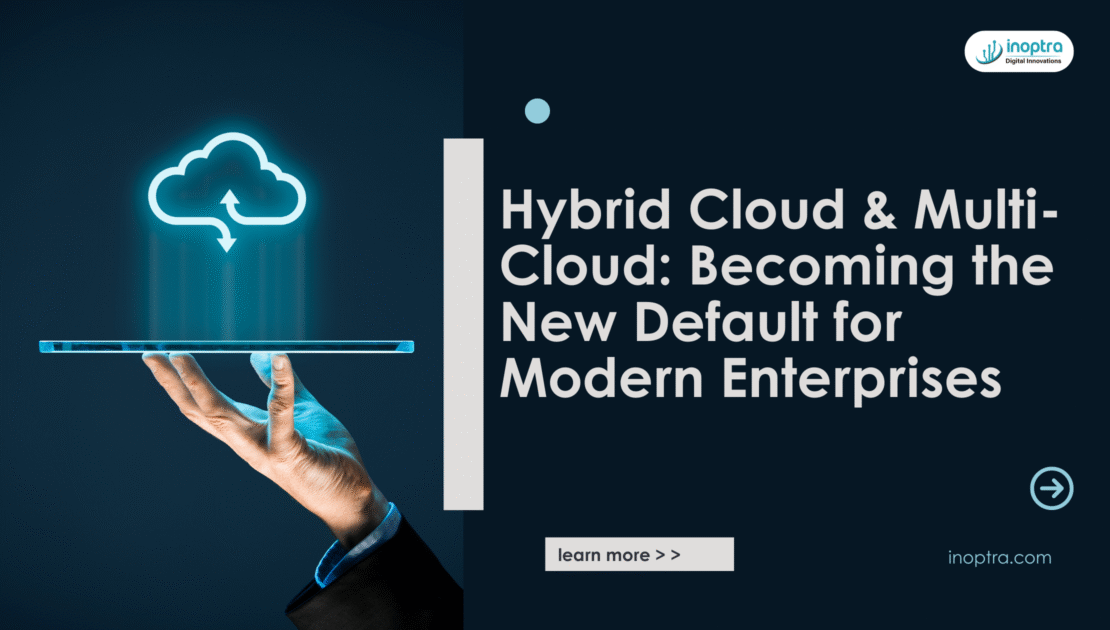What’s in the blog:
The cloud computing landscape has evolved far beyond the days of single-provider strategies. Today, hybrid and multi-cloud architectures are no longer just buzzwords—they are the default strategy for organizations seeking flexibility, resilience, cost efficiency, and compliance.
As businesses continue their digital transformation journeys, the question is no longer “Should we move to the cloud?” but rather “Which cloud—or combination of clouds—best fits our needs?”
What is a Hybrid Cloud?
A Hybrid Cloud combines on-premises infrastructure (private cloud) with public cloud services (like Azure, AWS, or Google Cloud). This integration allows data and applications to move seamlessly between private and public environments.
Key Characteristics:
- Mix of on-premises and cloud-based resources
- Unified management and orchestration
- Secure data exchange between environments
- Flexibility to run workloads where they perform best
Example:
A financial organization stores sensitive customer data in a private cloud for compliance reasons while using Azure or AWS public cloud to run analytics workloads that require high scalability.

What is a Multi-Cloud?
A Multi-Cloud strategy means using multiple public cloud providers—for instance, using Azure for AI workloads, AWS for storage, and Google Cloud for analytics.
Key Characteristics:
- Utilizes services from multiple cloud providers
- Avoids vendor lock-in
- Optimizes performance and cost by matching workloads to provider strengths
Example:
A global e-commerce company might use:
- Azure for virtual machines and directory services
- AWS for its global content delivery network (CDN)
- Google Cloud for data analytics and machine learning
Why Hybrid & Multi-Cloud Are Becoming the Default
1. Flexibility and Freedom of Choice
Businesses today demand flexibility. Hybrid and multi-cloud architectures allow organizations to choose the best cloud for each workload, avoiding dependency on one provider.
💡 Example: A healthcare firm may use Azure for compliance-ready workloads while leveraging AWS for IoT-driven patient monitoring.
2. Cost Optimization
Each cloud provider has different pricing models and performance advantages. With a hybrid/multi-cloud approach, organizations can run workloads where they are most cost-efficient, whether on-premises or across different clouds.
Tip: Use tools like Azure Arc or Google Anthos for unified governance and cost management across environments.
3. Business Continuity and Resilience
Outages and regional failures can disrupt operations. Multi-cloud deployment ensures redundancy and disaster recovery—if one provider goes down, workloads can automatically failover to another.
✅ Example: A bank hosting mission-critical apps across Azure and AWS ensures zero downtime during outages.
4. Compliance and Data Sovereignty
Many industries—like finance, healthcare, and government—must comply with strict data residency laws. Hybrid cloud models allow sensitive data to stay on-premises while leveraging cloud scalability for non-sensitive workloads.
📜 Example: An organization keeps customer PII in its private data center while using Azure for scalable web applications.
5. Innovation Without Disruption
Hybrid and multi-cloud models empower organizations to adopt new technologies (like AI, ML, and IoT) without fully abandoning existing systems.
For instance, Azure Arc and AWS Outposts extend cloud-native services to on-premises data centers, enabling consistent innovation across environments.

Key Technologies Driving Hybrid & Multi-Cloud Adoption
| Technology | Description | Example |
|---|---|---|
| Azure Arc | Extends Azure management to on-premises and multi-cloud environments | Manage AWS EC2 and on-prem servers from Azure |
| AWS Outposts | Brings AWS services to on-premises data centers | Consistent hybrid cloud experience |
| Google Anthos | Enables unified application management across multiple clouds | Run Kubernetes clusters across clouds |
| VMware Cloud | Allows workload mobility between private and public clouds | Seamless migration between VMware and Azure/AWS |
| Kubernetes | Container orchestration platform for multi-cloud workloads | Deploy apps consistently across Azure, AWS, and GCP |
Challenges in Adopting Hybrid & Multi-Cloud
While the benefits are substantial, organizations must address these challenges:
- Complex management and monitoring
- Data security and governance
- Skill gaps in managing diverse environments
- Networking and integration complexities
- Cost visibility across clouds
Solution Approaches
- Use centralized cloud management tools (e.g., Azure Arc, CloudHealth, Prisma Cloud)
- Implement Zero Trust security frameworks
- Adopt DevSecOps practices for continuous security integration
The Future of Cloud Strategy
According to Gartner, by 2027, over 80% of enterprises will have adopted a hybrid or multi-cloud infrastructure.
The trend is clear — the future of cloud is not one cloud, but many working together.
Future advancements like AI-driven cloud management, cross-cloud automation, and unified observability platforms will further simplify hybrid and multi-cloud operations.
Key Takeaways· 🌐 Hybrid Cloud: Mix of on-prem + public cloud for flexibility · ☁️ Multi-Cloud: Multiple cloud providers for workload optimization · 💡 Benefits: Cost efficiency, resilience, compliance, and innovation · 🧠 Future: Unified management and AI-driven automation |
How Inoptra Accelerates Your Hybrid & Multi-Cloud Success
At Inoptra, we understand that cloud adoption isn’t just a technology shift—it’s a strategic transformation. Our mission is to help organizations simplify cloud complexity, enhance security, and accelerate innovation across hybrid and multi-cloud environments.
Our Expertise Includes:
- 🌐 Cloud Strategy & Assessment: We analyze your current environment and design a roadmap aligned with your business goals.
- ☁️ Cloud Migration & Integration: Seamless, low-risk migration across Azure, AWS, GCP, and private infrastructure.
- 🔒 Security, Compliance & Governance: Multi-layered protection and industry-specific compliance across distributed clouds.
- ⚙️ DevOps & Automation: Accelerate delivery pipelines and improve operational agility through DevSecOps and automation.
- 💡 AI/ML & Intelligent Operations: Leverage AI-powered insights for smarter workload management and predictive optimization.
- 📊 Cost Management & Optimization: Data-driven analysis to minimize waste and maximize ROI across all environments.
- 🛡️ Managed Cloud Services: Continuous monitoring, performance tuning, and support for a stable and secure hybrid ecosystem.
With a team of certified cloud professionals and a customer-first approach, Inoptra empowers businesses to innovate confidently—bridging on-premises and cloud worlds without disruption.


